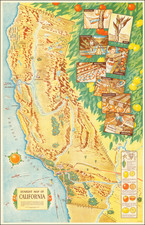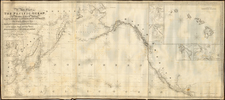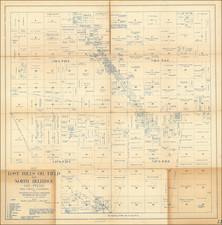English Gold Speculators In California--Sir Henry Vere Huntley & John C. Fremont Connections
Unrecorded Porcelain Card, promoting the works of the Anglo-American Gold Mining and Dredging Company, which was established in 1849 to promote a mining venture on the Calaveras River, but ultimately wound up doing business with John C. Fremont's Mariposas Company.
The view is a promotional item for the Anglo-Californian Gold Mining and Dredging Company, part of a series of ventures established in London by Luke Williams, beginning in March 1849, which led to the funding of an expedition to California led by Sir Henry Vere Huntley. The view shown here is of great interest in connection with the company's activities, as it may reflect the only surviving evidence of the original drawings obtained by the company and used to provide evidence of the company's initial venture, a quartz gold mining venture on the Calaveras River. Of note, it describes the "House of Iron" and "Hill" contained in the drawings described in the newspaper accounts below, although the steamship shown on the navigable river appears to have been toned down by the artist of this Porcelain Card, who shows only a small sailboat.
This is also the only evidence of the company's fund raising efforts in France (or Belgium, where this Porcelain card was acquired in 2016).
The Company's involvement in the project seems to be based on a drawing sent to London by its "agents" James Palmer and Captain Tremaine. The existence of Palmer and Tremaine was the subject of considerable speculation, even at the time. When Sir Henry Huntley arrived in California as the company agent, he was unable to locate Palmer or Tremaine. This led him to investigate other options, which resulted in Huntley's securing leases from John C. Fremont's Mariposas Company for mining Gold Quartz.
The Anglo-Californian Gold Mining Company
Little is known about the company, most of it derived from contemporary newspaper sources and the accounts of Huntley. It was set up by Luke Williams, who has been described as a serial promoter of California Gold Rush investments in London, although it might be more fair to characterize his activities in terms of his efforts to launch the Anglo-Califorian Gold Mining Company, apparently based upon the drawings and reports of its first agents, Palmer and Tremaine.
While the very existence of Palmer and Tremaine was questioned, the "drawings" referred to in the newspaper accounts below are unquestionably the source of the illustration set forth in the Porcelain Card for the Santa Vaga mine which we offer here.
The following advertisement was published in the Sportsman's Pilot and Betting House Guide . . . No. 1, January 1850 at Page 70. A similar advertisement was run in The Cardiff and Merthyr Guardian Glamorgan Monmouth and Brecon Gazette on February 16, 1850:
The Anglo-California Gold Mining and Dredging Company.
Capital, £50,000 in Shares of 10s. each. Deposit, 10s. Share.
OFFICES :-Albion Chambers, Adam-street, Adelphi, London.
THIS COMPANY having amalgamated with an American party and secured the right to work the newly-discovered Gold Mines of Santa Vaga and other places near the Calaveres River, in Upper California, now beg to offer their remaining Shares to the Public. The spot selected for operations is well known as one of the richest in California. Dredging as well as Mining operations will also be carried on, and the whole of the locality belonging to the Company will be made available as quickly as possible. In addition to the great wealth of the mines, it is expected that the River Calaveres and its tributaries, will yield an unprecedented amount of treasure, that stream flowing from the native source of the Gold in Sierra Nevada.
The first expedition, under the superintendence and direction of Capt. Sir Henry Vere Huntley, R.N., will leave England by the "John Calvin" in a few days. The second expedition will leave by the Ship "Sacramento," preparing to sail early in February.
There will be no liability whatever incurred by Shareholders beyond the payment of the 10s. per Share, and applications, accompanied by the deposit of 5s. per Share, may be made at the Offices, when the shares will be immediately delivered or sent per Post. Post Office Orders may be made payable to the Manager. By order of the Committee,
LUKE WILLIAMS, Manager.
London, 1st Jan. 1850.
The Company sent Huntley and a group of 9 Cornish miners to California in early 1850. By August 1, 1850, a report from San Francisco was published, noting the following activities of the Company in California, as later reported in The Islander (Charlottetown, Prince Edward Island) on December 6, 1850.
The English Vessel, the John Calvin, arrived here [San Francisco] in the beginning of last month [July], brinigng nine Cornish miners and Sir Henry Vere Huntley (a Captain in the English Navy) as superintendent of the company.
The origin of this company has been related . . . as follows: . . . The Anglo-Gold Company was got up in London upon reprsentations sent from this country by a Mr. James Palmer and a Captain Tremaine. Negotiations were opened . . . which resulted in their sending to London various flattering reports, plans views and sketches of a part of California where "quartz gold" was so abundant as to make it appear a desirable invesment. The "bait" took; the "investment" was made. Messrs. Palmer and Tremaine bought a fine gold-bearing tract of land for the company on the "Calaveras" navigable river, of which they sent a view, with an imaginary steamer nestling on its bossom, as well as of a house--an iron house I think--put up on the bank or rill, just suited to supply water to the gold-washing machines in their operations. There was some mention of a hill also, but its whereabouts I forget, nor do I know the object of including it in the picture, unless indeed, it contained "quartz gold." The scene of this "representation" was laid in the district of country known as Stockton mines, about 150 miles south of San Francisco. Sir Henry Huntley on his arrival makes all sorts of inquires for Messrs. Palmer and Tremaine, who he expected would call upon him immediately as it was known the John Calvin had arrived. It then occurred to him that he might be more successful in a search on the Calaveras; they might probably be keeping the location clear of "squatter." He proceeds there, rides about with a guide up hill and down dale, in all sorts of directions . . . for two days . . . but finds nothing of the gentlemen, nor the location, nor of the "house," nor of the "hill," nor of the "steamer," nor of the "quartz gold." In short, he only finds that the company (to use the expression more remarkable for its force and aptness in the case than for its elegance in any case) has been "done," "done brown." Giving up the search for Messrs. Palmer and Tremaine, of whom even tradition in California "saith not aught," Sir Henry returned to San Francisco, falls in here with another company, the Mariposa Mining Company. . . . The Mariposa Company made a proposal to Sir Henry's company that the two should "amalgamate," on condition among other things that the London company put in £100,000 or $500,000, and that then they should start equal, and share profits half to each. Sir Henry has sent the proposal to London . . .
I understand that suspicions have been cast uipon this London company already. I know nothing of them further than I have related, and I can have no desire to injure tham or to prejudice their interests in any way. Their undertaking is not at all Quixotic, in my opinion. . . . They have overcome the greatest difficulty which besets undertakings of this sort, namely, getting their men to the mines.
There are one or two other points, however, which seem to require explanation from them. First, it would be satisfactory to know that the communications said to have taken place with Messrs. Palmer and Tremaine did really take place, for, if those are not feigned, why, then, the company duped and swindled, as one can hardly suppose that those gentlmen worked gratuitously. One of them must have been a good draughtsman, and time is valuable in California. The next fact that excites one's curiosity to ascertain is the amount they "drew" out of the company. I dare say a good sum if the truth was known. I should also like to know what title they sent hom for the land. I think the company was lucky to get the land. They would have had a fight with "Uncle Sam" one day for the possession. . .
I am now bound in justice to all parties to add, that from all I could see and learn the company has performed all its engagements to the Cornish miners with fidelity. . . .
Interestingly, the Mariposa Company referenced above was John Fremont's Mariposa Company. On November 24, 1850, Sir Henry Huntley reported back to London "probably the first formal report on a California quartz mine . . . describing in some detail the operations and yield of the Mariposas mine and embodying a brief description of the Fremont holdings." (Underhill, From Cowhides to Golden Fleece: A Narrative of California, 1832-1858, p. 215). The author notes that "Huntley, who represented the Rothschilds, was offered an interest in the Mariposas mine for $500,000; instead he contracted for some leases with Colonel Fremont." (emphasis added).
Huntley would ultimately publish an account of his time in California entitled California: Its Gold and Its Inhabitants. By the Author of "Seven Years on the Slave Coast of Africa," "Peregrine Scramble," &c. (1856). Gary Kurutz, in The California Gold Rush 348a, notes
The author came to California in 1850 as Chief Superintendent of the Anglo-California Gold Mining Company. His book, however, is based on his 1852 journal. During that year, the Englishman journeyed from San Francisco to Sacramento, Marysville, Placerville, and Columbia. Although somewhat disjointed in style, his account provided worthwhile descriptions of ship arrivals, fires, floods, duels, shootings, lynchings, hotel accommodations, expensive food, travel, movement of the state capital, drunken newspapermen, and the general state of mining. All except the gold and mint juleps made California less than desirable. Huntley also produced a report on the Mariposa District in the Rocky-Bar Mining Company Report, 1851 and the report for the Anglo-California Gold Mining Company.
Luke Williams
Luke Williams was perhaps the most prolific of the British promoters of the California Gold Rush. Woodland notes that he was the only "Quadruple Promoter" of the era, forming 4 different ventures to exploit the gold mining regions in California and Australia. Williams became involved with the California Gold Regions Mining Association in March 1849. However, his first role as promoter came with William Frederick Chevin, when the two formed the Anglo California Gold Mining and Dredging Company in December 1849, which acquired the prior entity.
While the venture raised sufficient funds to send Sir Henry Huntley on a first expedition to California, The Times was already referring the the venture as a "dubious scheme" on May 30, 1850 (page 7). The company continued to raise money and sent out a second party to California. However, on August 31, 1850, the two formed a second company, which they called The Anglo Californian Gold Mining and Dredging Company.
On October 22, 1850 and October 23, 1850, the Times published correspondence a letter from California expressing doubt about the venture and noting that Sir Henry Huntley had been unable to locate the company's original representative, James Palmer, nor the mines' owner, nor any mines at all. Instead, Sir Henry had negotiated an agreement with the Mariposa Company and put the Company's miners to work there.
Luke Williams would next register the British Mariposa gold Mining Company on November 27, 1850, although this company took no further action. Finally on December 31, 1850, Williams renamed the second entity the Anglo California Gold Mining Company, but the name changed once more to Anglo Californian Gold Mining Company on March 29, 1851.
Rarity
The Porcelain Card is unrecorded--we find no other evidence of its existence or survival in any reference work or other source.









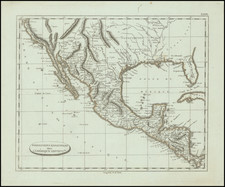
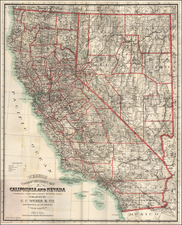
![(Humboldt Atlas and Text) Geographique et Physique du Royaume de Nouvelle-Espagne [with quarto text:] Essai Politique de la Royaume de la Nouvelle-Espagne](https://storage.googleapis.com/raremaps/img/small/99796.jpg)
